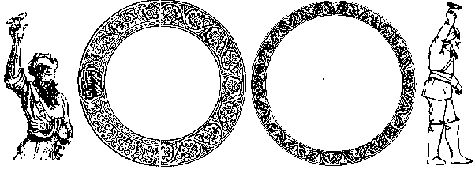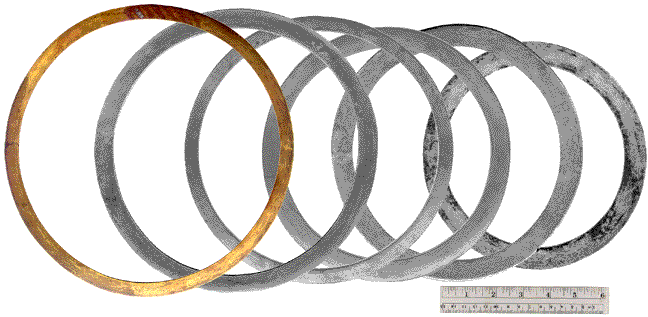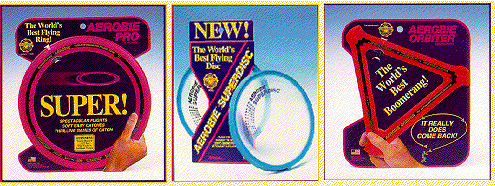|
The Chakram (or Chackrum or Chackram or Chackra) is a metal ring that has been used as a throwing device by the Sikhs of India for many hundreds of years. The Sikhs became martial under Guru Govind Singh and used the Chackra effectively against the Moghul dynasty. The Chackrum has a history that is as old as Indian civilization itself. It's useage is embedded in Indian myth and legend. In the epics..the Mahabharata for instance...an asura trying to get heavenly nectar from the moon had his head chakra-ed off. Still he tries to swallow the moon and succeeds ever so often before the moon escapes through the cut neck...an eclipse myth. Sculptures and paintings of many gods and godesses show the chakra being twirled. "In my youth there were people who practiced with different versions and sizes...twirling. throwing overhand and underhand. In the thrities and forties street thugs threw little chakras overhand and underhand in Calcutta." - Joy Chaudhuri A small Chakrum is called a Quoit. The following illustrations show how the Quoit is thrown and how it can be ornately decorated. Sometimes the Quoit is inlaid with Silver or Gold. Often it is plain or has small incised decorations. The Quoit was often worn as part of a warrior's armour for decorative purposes. 
The Quoit is generally 6 to 8 inches in diameter. It has a razor sharp edge and was thrown by twirling it around the warrior's index finger which was tucked in for the release. The Quoit was accurately thrown 60 to 100 metres. Two forms of the metal throwing ring exist. Chakkar Sada has a smooth and sharp outer edge. Chakkar Katavdar had a serrated outer edge. References about Chakram include the following: 1) "A Glossary of the Construction, Decoration and Use of Arms and Armour" by George C. Stone ISBN 0-517-065878 2) "The Complete Encyclopedia of Arms and Waeponz" edited by Leonid Tarassuk and Claude Blair ISBN 0-517-48776-4 3) "Indian and Oriental Armour "by Lord Egerton of Tatton, London, England, 1896 4) "Studies in Indian Waeponz and Warfare" by G. N. Pant; Army Education Stores, India
This section shows six Chakram metal (brass & steel) throwing rings from India ( theruler at bottom right is 6 inches in length). These are too large to be classified as Quoits. The smallest ring has an outer diameter of 8.3 inches. The largest ring has an outer diameter of 10.8 inches. The Steel Chakram have sort of a triangular cross section with a razor sharp outer edge. The upper surfaces are curved. The lower surfaces are flat (see graphic below). The Brass Chakram appears to be a strip that was rolled into a hoop and then brazed to form a solid ring. The entire inner edge lies above the entire outer edge as though it were formed over a spherical body. The cross section is a sophisticted semi-elliptical airfoil. The brass Chakram really flies well. I have thrown it for more than 100 metres and it has a stable straight flight. The steel Chakram fly only 40 - 60 metres. |

|
Examples of Chackrum airfoiling technology: steel (left) and brass (right). Outer edges are on the right. Would you like to see 100% Scale photographs of the above Chakram? If so, please visit the following links: Chakram #1 (not shown above): Premium example with complex detailed art on both sides. From the DeYoung Museum collection in San Francisco: weight = 190 gm; outer diameter = 210 mm; inner diameter = 153 mm; max thickness = 2.5 mm Chakram #2: Brass throwing ring with complex airfoiling: weight = 132 gm; outer diameter = 275 mm; inner diameter = 245 mm; max thickness = 1.0 mm Chakram #3: Steel throwing ring with simple art: weight = 192 gm; outer diameter = 269 mm; inner diameter = 233 mm; max thickness = 1.8 mm Chakram #4: Steel throwing ring with simple art: weight = 160 gm; outer diameter = 250 mm; inner diameter = 225 mm; max thickness = 2.0 mm Chakram #5: Steel throwing ring with simple art: weight = 260 gm; outer diameter = 236 mm; inner diameter = 197 mm; max thickness = 3.0 mm Chakram #6: Steel throwing ring: weight = 280 gm; outer diameter = 239 mm; inner diameter = 199 mm; max thickness = 3.0 mm Chakram #7: Steel throwing ring: weight = 126 gm; outer diameter = 212 mm; inner diameter = 174 mm; max thickness = 1.2 mm More Chakram links: Eighteenth Century Indian Chakram with Silver Inlay. ; Whoosh Chakram. If you would like to see photos of a Chakram that ICON produced as a replica of Xena's famous Chakram throwing ring, please visit my XENA Chakram Web Page #1 and XENA Chakram Web Page #2. Alan Adler of Aerobie, Inc. designed his famous Aerobie® long distance throwing rings by starting with the Chackrum and adding sophisticated rubber and plastic material airfoiling. Alan came up with a winner! If you haven't tried throwing an Aerobie® product, you should try one of these. I have personally thrown an Aerobie® more than 250 metres. There are two different Aerobie® flying rings which have diameters of 10 and 13 inches. There is also a flying disk and a flying triangle boomerang. They are all a lot of fun. You can find these for sale in toy stores at prices under $10, or you can order this product by clicking on the link for flying rings & discs in the flight-toys.com catalog.  |
Back to: Flight Toys